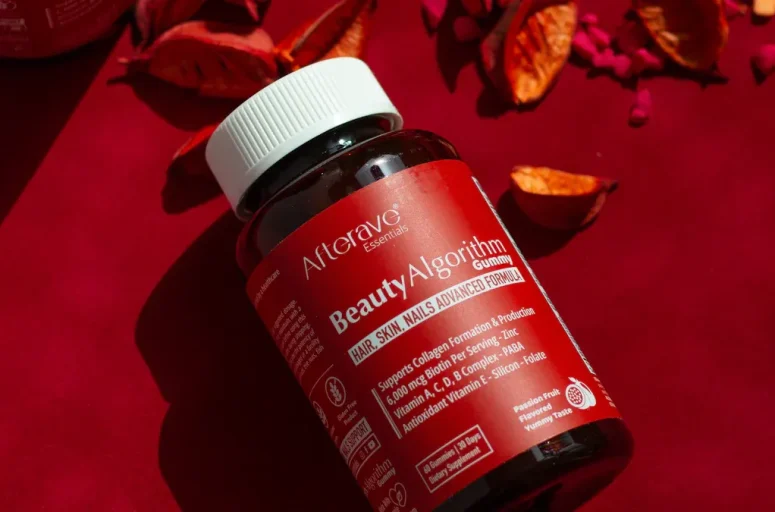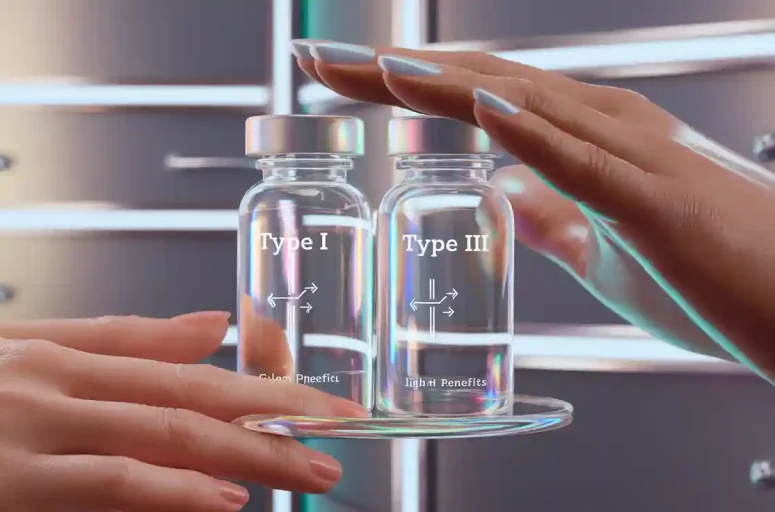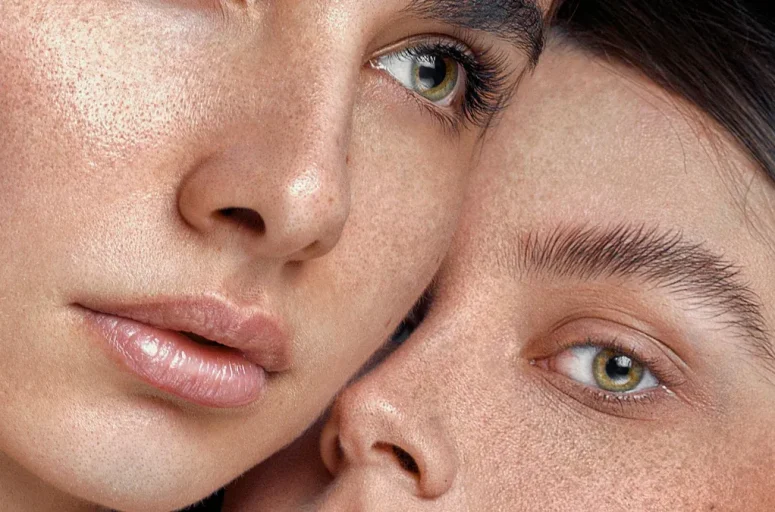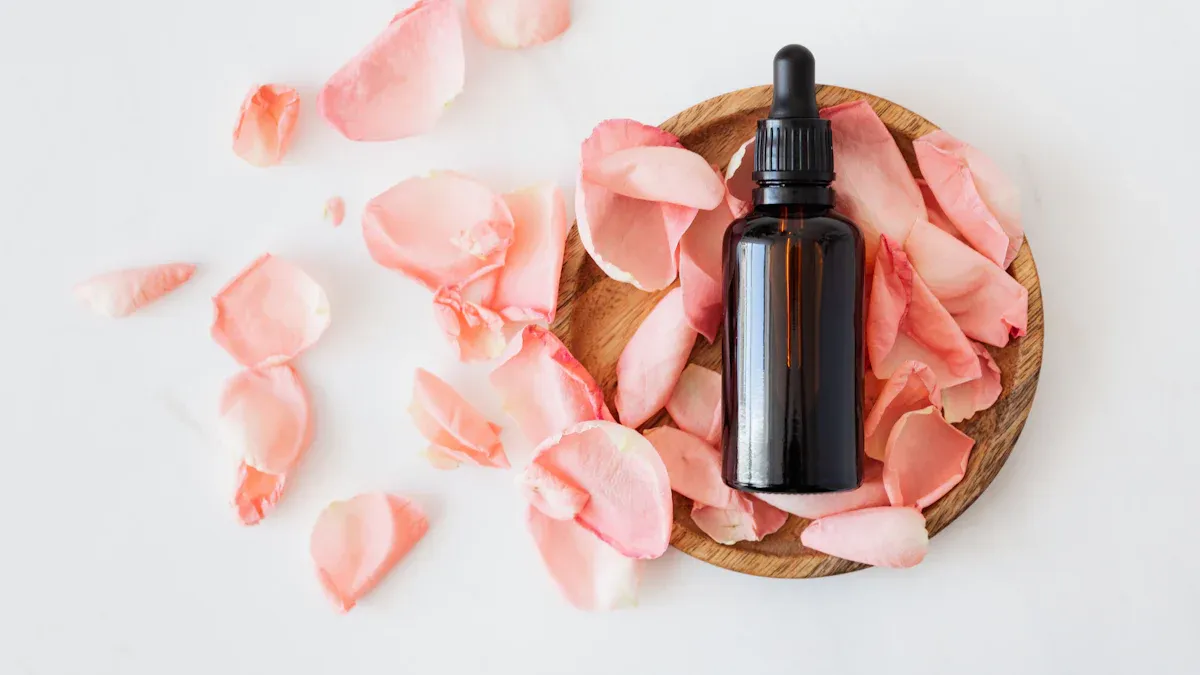
Astaxanthin, known as the “king of antioxidants,” offers numerous astaxanthin benefits that protect your skin. It stops harmful free radicals, keeping your skin safe from damage. This helps your skin look healthier and younger over time. Unlike other antioxidants, it penetrates deep into the skin. It boosts elasticity, smooths wrinkles, and keeps skin hydrated. Adding astaxanthin to your routine can make your skin glow. Its amazing benefits make it perfect for long-lasting skin health.
Key Takeaways
Astaxanthin is a strong antioxidant that protects skin from damage. It helps keep your skin looking young and fresh.
It boosts skin moisture and flexibility, making it soft and glowing.
Using astaxanthin often can reduce wrinkles and fine lines. This helps your skin look smoother and healthier.
Astaxanthin defends your skin from sun damage caused by UV rays. It helps stop early aging from too much sun exposure.
This antioxidant also protects skin from pollution and other harmful things. It keeps your skin strong and healthy.
You can get astaxanthin by eating foods like salmon or shrimp. You can also take supplements for extra benefits.
Skincare products with astaxanthin can help fix skin problems. They improve your skin’s overall health.
Be consistent; follow your routine to see better skin over time.
What Is Astaxanthin?
Astaxanthin is a natural pigment from the carotenoid family. It gives bright red, orange, and pink colors to some sea animals and plants. Astaxanthin is a strong antioxidant with many health benefits, especially for skin. Its special structure helps fight free radicals and shields cells from damage.
Natural Sources of Astaxanthin
Astaxanthin comes from marine life and microalgae found worldwide. These sources are rich in astaxanthin and easy to find. Below are some common sources:
Source | Regions Found |
|---|---|
Yeast | India, Australia, South Korea, Thailand, Latin America, Brazil, Argentina, Middle East and Africa, Mexico, Europe, UK, Germany, France, Italy, Spain, Denmark, Sweden, Norway, Asia Pacific, Japan, China |
Krill/Shrimp | India, Australia, South Korea, Thailand, Latin America, Brazil, Argentina, Middle East and Africa, Mexico, Europe, UK, Germany, France, Italy, Spain, Denmark, Sweden, Norway, Asia Pacific, Japan, China |
Microalgae | India, Australia, South Korea, Thailand, Latin America, Brazil, Argentina, Middle East and Africa, Mexico, Europe, UK, Germany, France, Italy, Spain, Denmark, Sweden, Norway, Asia Pacific, Japan, China |
Microalgae like Haematococcus pluvialis have the most astaxanthin. The amount of astaxanthin differs by source. For example, Arctic shrimp has about 1,200 ppm, while Haematococcus pluvialis contains up to 40,000 ppm.
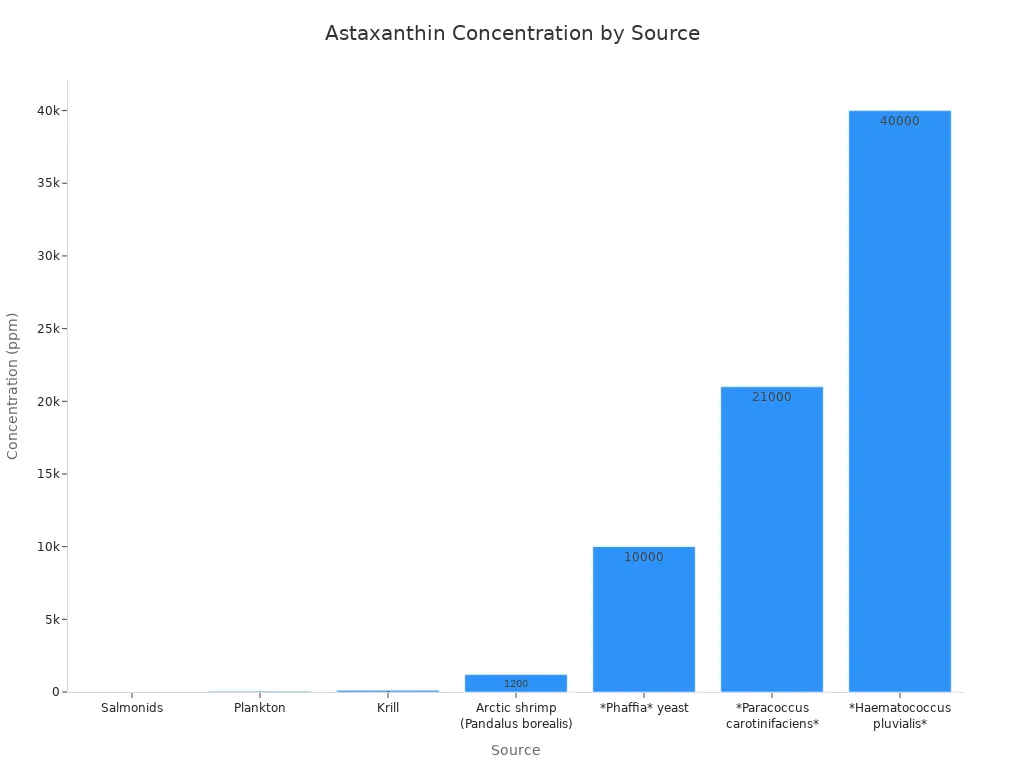
Unique Antioxidant Properties
Astaxanthin is a strong antioxidant that fights oxidative stress. It protects the whole cell membrane, unlike other antioxidants. Studies show it helps skin by reducing dark spots, melanin, and aging caused by sunlight. People in these studies saw fewer wrinkles, better elasticity, and more hydrated skin.
Astaxanthin also boosts the body’s defenses. It increases superoxide scavenging, which removes harmful substances. This makes it great for protecting skin and improving overall health.
How Astaxanthin Stands Out Among Antioxidants
Astaxanthin works better than many other antioxidants. Here’s how it compares:
It is 10 times stronger than β-carotene at fighting free radicals.
Its antioxidant power is 100 times greater than α-tocopherol (Vitamin E).
It beats other carotenoids like lutein and canthaxanthin in many ways.
These features make astaxanthin a top choice for keeping skin healthy and youthful.
Astaxanthin Benefits for Skin
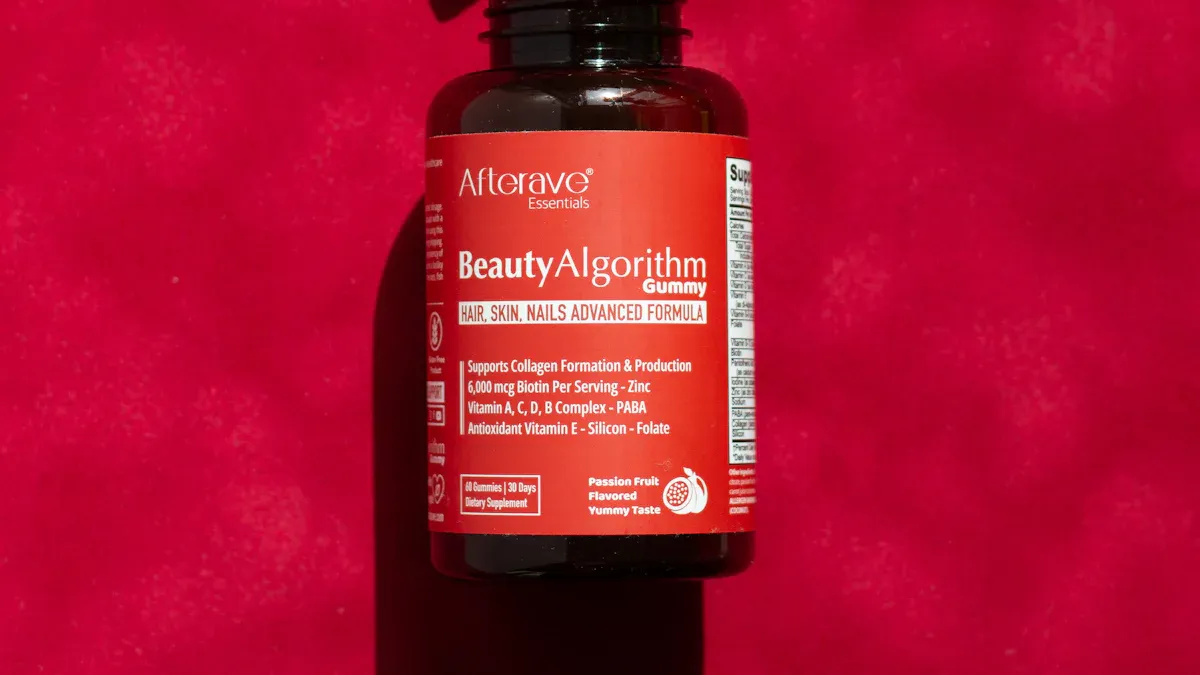
Anti-Aging and Wrinkle Reduction
Astaxanthin helps fight signs of aging like wrinkles. It stops free radicals, which cause skin damage and fine lines. This protection keeps your skin smoother and looking younger.
Studies show astaxanthin reduces rough skin and boosts elasticity. In one study, people saw smoother skin after four weeks. Over time, wrinkles became less visible, and skin texture improved.
Astaxanthin also helps your skin make collagen. Collagen keeps skin firm and strong. It goes deep into the skin to protect and nourish it. This makes it great for reducing aging signs and getting radiant skin.
Improved Skin Hydration and Elasticity
Astaxanthin helps your skin stay hydrated and stretchy. It locks in moisture, stopping dryness and flaky skin. Studies show an 84% hydration boost after seven days of use.
It also lowers water loss from your skin, keeping it soft. Over time, this improves texture and elasticity. One study showed a 51% moisture increase after six weeks.
Astaxanthin makes your skin glow naturally. It improves softness and brightness, giving you healthy-looking skin. If your skin feels dry or dull, astaxanthin can help.
Protection Against Sun Damage
The sun can harm your skin and cause early aging. Astaxanthin protects your skin from UV rays and sunburn. It stops damage caused by sunlight and keeps skin healthy.
Research shows astaxanthin lowers water loss from UV exposure. After 70 days, people using astaxanthin had better moisture levels. This shows it helps your skin stay hydrated in tough conditions.
Astaxanthin also stops enzymes that break down collagen and elastin. These proteins keep skin firm and smooth. By protecting them, astaxanthin helps prevent wrinkles from sun damage.
Protection from Environmental Damage
Every day, your skin faces challenges like pollution, sunlight, and bad weather. These things can make your skin age faster, dry out, and weaken. Astaxanthin helps protect your skin and keeps it strong.
Astaxanthin stops free radicals caused by environmental damage. Free radicals are harmful molecules that hurt skin cells. They cause wrinkles, dark spots, and make skin less firm. By fighting these, astaxanthin slows aging and keeps skin youthful.
Studies show how well astaxanthin defends against damage:
In 2012, Tominaga et al. found that taking 6mg daily improved skin elasticity, reduced wrinkles, and kept skin hydrated after six weeks.
A 2006 study by Yamashita showed 4mg daily boosted skin moisture, elasticity, and reduced UV aging signs in four to six weeks.
Research by O’Connor & O’Brien in 1998 found astaxanthin is 100 times stronger than beta-carotene and 1000 times stronger than lutein at protecting skin from UVA damage.
Pollution also harms skin by clogging pores and breaking its barrier. Astaxanthin helps repair skin and keeps it hydrated. It stops pollutants from getting deep into your skin. This makes it great for people in cities.
Adding astaxanthin to your routine protects your skin from harm. Use it in supplements or creams to keep your skin glowing and healthy.
Clinical Evidence of Skin Benefits
Studies on Anti-Aging Effects
Astaxanthin helps reduce wrinkles and fine lines. It fights free radicals that harm your skin and cause aging. By stopping this damage, it keeps your skin smooth and youthful.
Studies show it improves skin elasticity and reduces roughness. People using astaxanthin for weeks noticed better skin texture. This makes it a great choice for firmer, healthier skin.
Research on Hydration and Skin Texture
Astaxanthin helps your skin stay hydrated and soft. It locks in moisture, stopping dryness and flaky skin. Research proves these benefits. Below are some study results:
Study Description | Findings |
|---|---|
Six-week study with 28 participants taking 4 mg daily | Better skin hydration and elasticity |
Clinical studies on astaxanthin treatment | Less roughness, dryness, and better sebum balance |
Study in Journal of Cosmetic Dermatology | 78% denser skin after three months, fewer fine lines |
These studies show astaxanthin improves hydration and texture. If your skin feels dry or rough, it can help.
Evidence for UV Protection and Damage Repair
Astaxanthin protects your skin from harmful UV rays. It stops damage by fighting reactive oxygen species (ROS). These molecules harm proteins like collagen and elastin, which keep skin firm.
Research shows astaxanthin helps cells recover from UV damage. It also protects DNA from harm caused by sunlight. Its power is stronger than other carotenoids. This makes it great for preventing and fixing sun damage.
Which Skin Types Benefit from Astaxanthin?
Benefits for Dry and Dehydrated Skin
Astaxanthin helps dry skin stay hydrated. It traps water in your skin. This stops moisture from escaping, even in tough weather. It also makes your skin barrier stronger. A strong barrier protects against dryness from wind or pollution.
Studies show astaxanthin boosts skin hydration a lot. It helps your skin hold water better. This is great for flaky or tight skin. Using astaxanthin often can make your skin soft and glowing.
Effects on Aging and Mature Skin
Astaxanthin fights aging by stopping free radicals. Free radicals harm skin cells and cause wrinkles. They also make skin lose its stretchiness. Astaxanthin protects your skin and keeps it looking young.
Antioxidants like astaxanthin protect skin from damage. They also improve skin health. For example:
A study showed people with sun-damaged skin improved after 12 weeks. They took astaxanthin and collagen and saw better hydration and elasticity.
Astaxanthin likely helped by lowering oxidative stress.
Astaxanthin also helps your skin make collagen. Collagen keeps skin firm and smooth. Adding astaxanthin to your routine can reduce wrinkles and make skin stronger.
Suitability for Sensitive and Acne-Prone Skin
Astaxanthin is gentle for sensitive or acne-prone skin. It calms redness and irritation. If you have breakouts or inflamed skin, astaxanthin can help it heal.
Unlike some products, astaxanthin won’t clog pores. It protects skin from pollution and stress that cause acne. By making your skin stronger, it helps keep it clear and healthy.
Astaxanthin also blocks pollution from harming your skin. This is helpful for acne or sensitive skin. Adding it to your routine can keep your skin calm and balanced.
How to Use Astaxanthin for Skin Health
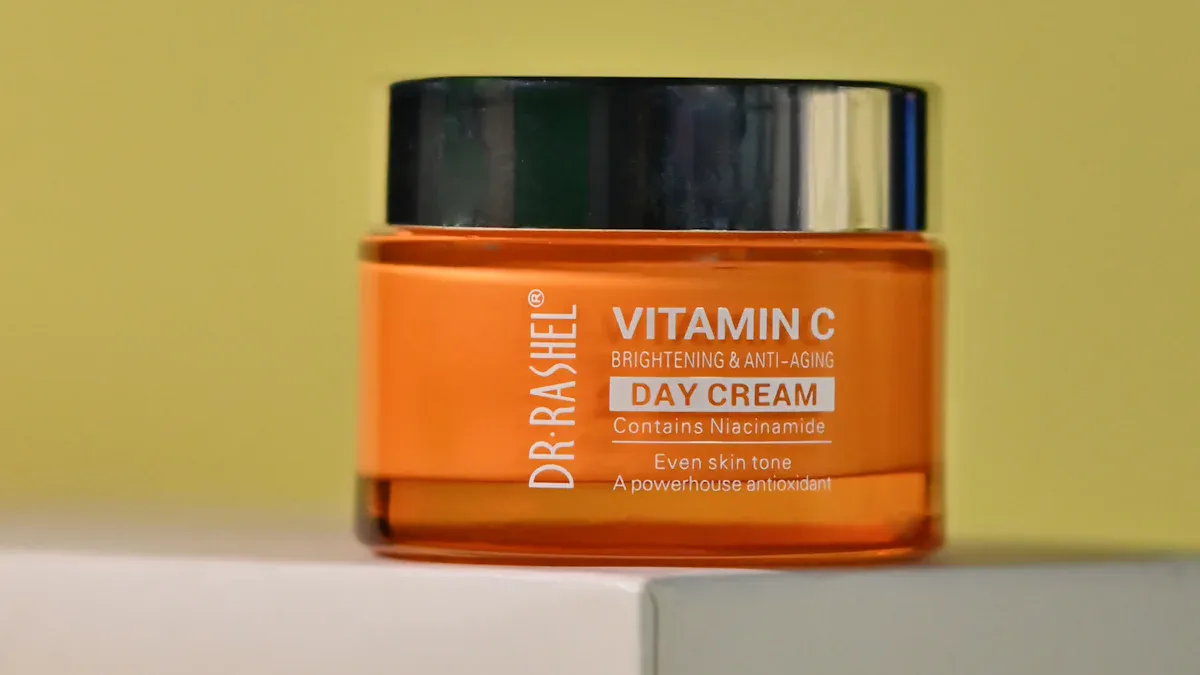
Foods with Astaxanthin
Eating foods with astaxanthin can help your skin. Many seafood and algae are great sources of this antioxidant. Sockeye salmon has the most, with 26 to 38 mg per kilogram. Rainbow trout and tiger prawns also have high amounts, with 24 mg/kg and 132.79 mg/kg, respectively.
Here’s a table showing astaxanthin levels in different foods:
Food | Astaxanthin (mg·kg-1 flesh) |
|---|---|
Sockeye salmon | 26-38 |
Rainbow trout | 24 |
Tiger prawn | 132.79 ± 1.5 |
Shrimp | 147.7 |
Crayfish | 153 |
Snow crab | 119.6 |
Other good sources include red algae (Haematococcus pluvialis), canned salmon, and salmon eggs. Adding these foods to your meals helps your skin and gives you other nutrients too.
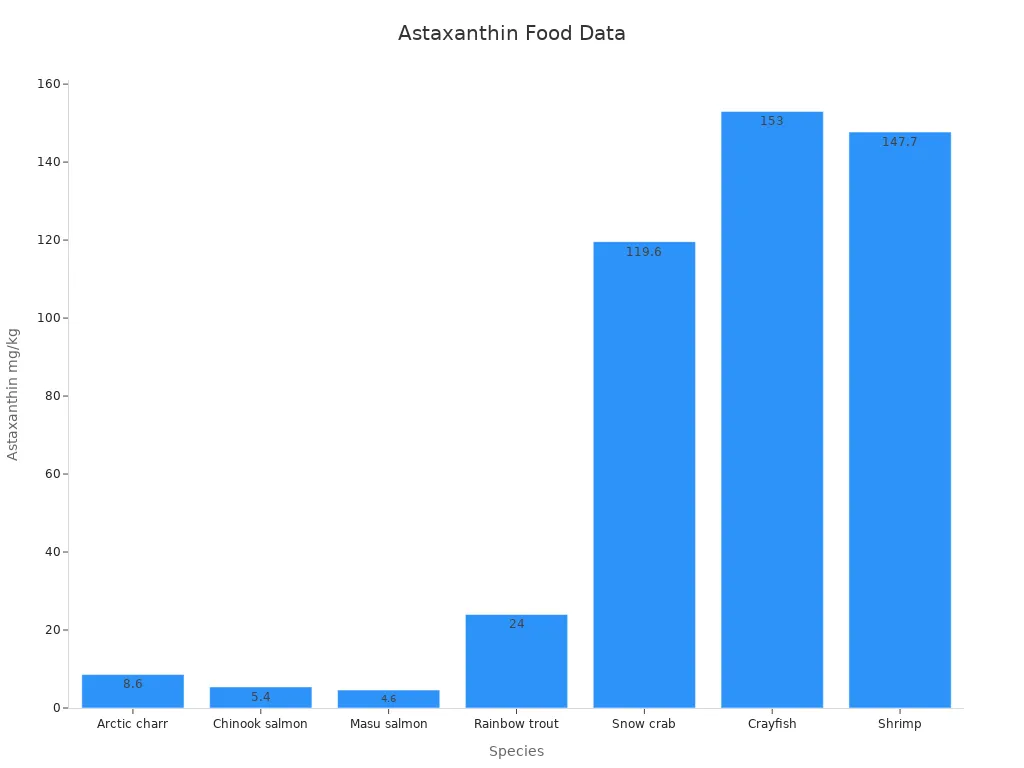
Astaxanthin Pills for Skin
If you don’t eat enough astaxanthin-rich foods, try supplements. These come as capsules or softgels and are easy to take daily. Studies show taking 4-12 mg of astaxanthin each day improves skin hydration, elasticity, and UV protection.
For better results, take astaxanthin with a meal that has fat. This helps your body absorb it 2 to 4 times better. Here’s a quick guide:
Tip | Details |
|---|---|
Best Absorption | Take with a meal that includes fat. |
Suggested Amount | 4-12 mg daily, based on research. |
Research supports the benefits of these supplements. For example, a 2012 study found that 6 mg daily reduced wrinkles and improved skin elasticity in eight weeks. Another study in 2018 showed better protection against UV damage.
Adding a supplement to your routine can make your skin healthier and brighter.
Skincare Products with Astaxanthin
Astaxanthin is also in creams and serums for your skin. These products deliver antioxidants directly to your skin, helping areas that need care. They reduce wrinkles, improve moisture, and protect from pollution and sunlight.
When picking a product, choose one with other helpful ingredients like vitamin C or hyaluronic acid. These extras boost the benefits for your skin. Use the product as directed, usually after washing your face and before applying moisturizer.
Skincare products with astaxanthin are great for targeting specific skin issues. They work well with foods and supplements, giving you a complete routine for glowing skin.
Tips for Adding Astaxanthin to Your Routine
Using astaxanthin in your skincare routine is easy and helpful. You can get it from food, supplements, or skincare products. Here are simple tips to get started:
Add It to Your Diet
Eat foods with astaxanthin, like salmon, shrimp, or trout. These foods also have omega-3s, which are good for you. Try to eat them twice a week. Cook tasty meals with these ingredients to make eating healthy fun.Pick the Right Supplement
If you don’t eat seafood, try an astaxanthin supplement. Choose a trusted brand with clear labels. Experts suggest 4-12 mg daily for skin benefits. Start small and increase if needed. Take it with healthy fats, like avocado, to help your body absorb it better.Use Skincare Products
Look for creams or serums with astaxanthin. Apply them after washing your face and before moisturizing. Follow the product’s directions and use it regularly for the best results.Combine Different Methods
For better results, use food, supplements, and skincare together. For example, eat salmon, take a supplement in the morning, and use a serum at night. This way, your skin gets astaxanthin inside and out.
Pro Tip: Take weekly photos of your skin. This helps you see changes like smoother, glowing skin over time.
Be Consistent
Stick to your routine to see results. It may take weeks to notice changes, so don’t give up. Set reminders to take supplements or use skincare daily. Over time, your skin will look healthier and brighter.
By following these tips, you can easily add astaxanthin to your routine. Its strong antioxidant power will protect and improve your skin, giving you a fresh, youthful glow.
Potential Side Effects and Precautions
Common Side Effects of Astaxanthin
Astaxanthin is safe for most people when used correctly. But, some may have mild side effects. These include:
Stomach discomfort: You might feel a little nauseous or have an upset stomach.
Skin discoloration: Taking too much can make your skin look slightly orange or pink. This isn’t harmful but might surprise you.
Allergic reactions: If you’re allergic to seafood or algae, you could get itchy, swollen, or red skin.
These effects are uncommon and usually not serious. If you feel anything unusual, stop using it and talk to a doctor.
Note: Always follow the dosage on the label. Taking too much increases the chance of side effects.
Who Should Avoid Astaxanthin?
Astaxanthin is safe for most, but some people should avoid it or be careful. You should take extra care if:
Pregnant or breastfeeding: There’s not enough research to know if it’s safe.
Low blood pressure: It might lower your blood pressure more, causing dizziness.
Taking medications: It could interfere with blood thinners, hormone treatments, or blood pressure medicine.
Allergic to seafood: Avoid astaxanthin from seafood or algae if you’re allergic.
Tip: If you take medicine or have health issues, ask your doctor before using astaxanthin.
Consulting a Dermatologist Before Use
Before using astaxanthin for your skin, ask a dermatologist. They can check if it’s good for your skin type and needs. They’ll also suggest the best form, like a cream, serum, or supplement.
Why seeing a dermatologist helps:
Personal advice: They’ll check your skin and recommend the right product or dose.
Avoid problems: They’ll make sure it won’t clash with your current skincare or medicine.
Track progress: Regular visits help adjust your routine and see results.
Pro Tip: Bring a list of your skincare products and supplements to your appointment. This helps your dermatologist give better advice.
By knowing the risks and being careful, you can safely enjoy astaxanthin’s benefits. Always put your health first and ask experts if unsure.
Astaxanthin is great for improving your skin. It helps keep your skin hydrated, makes it more stretchy, and reduces wrinkles. This gives your skin a fresh and youthful look. Its strong antioxidant and calming properties protect your skin from damage and keep it healthy.
Here’s a simple breakdown of its benefits:
Benefit | How Astaxanthin Helps |
|---|---|
Skin Hydration | Keeps skin moisturized |
Skin Stretchiness | Makes skin more elastic |
Wrinkle Appearance | Lessens visible wrinkles |
Oil Control | Reduces extra oil on the skin |
Antioxidant Power | Fights harmful free radicals |
Calming Effects | Soothes skin irritation |
Adding astaxanthin to your daily routine can make your skin healthier and brighter. You can get it from food, pills, or creams. Try it today and see how it transforms your skin!
FAQ
What’s the best way to use astaxanthin for skin?
You can use astaxanthin in supplements, foods like salmon, or creams. For supplements, take 4-12 mg daily. Eat it with healthy fats to absorb it better.
How long until astaxanthin shows results?
Most people see better skin hydration and texture in 4-8 weeks. Use it daily and stick to a good skincare routine for the best results.
Can astaxanthin replace sunscreen?
No, astaxanthin cannot replace sunscreen. It helps protect skin from UV rays inside your body. But sunscreen creates a shield on your skin. Use both for full sun protection.
Is astaxanthin safe for all skin types?
Yes, astaxanthin works for all skin types, even sensitive ones. It calms redness and strengthens your skin. If you’re unsure, ask a dermatologist.
Can I mix astaxanthin with other skincare products?
Yes, you can use astaxanthin with vitamin C, retinol, or hyaluronic acid. These combinations improve hydration and repair skin. Always test new products on a small area first.
Are there side effects of using astaxanthin?
Astaxanthin is usually safe. Rarely, it may cause mild stomach upset or slight skin color changes. Avoid it if you’re allergic to seafood or algae. Follow the recommended dose to stay safe.
Does astaxanthin help with acne?
Yes, astaxanthin helps calm acne by reducing redness and irritation. It also protects your skin from pollution and strengthens its barrier. Use it regularly for clearer skin.
Can pregnant women use astaxanthin?
Pregnant or breastfeeding women should avoid astaxanthin unless a doctor says it’s okay. There isn’t enough research to prove it’s safe during pregnancy. Always check with your doctor first.
Tip: Write down changes in your skin while using astaxanthin. This helps you see improvements over time.
